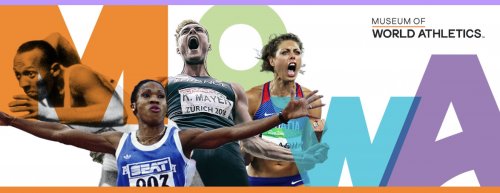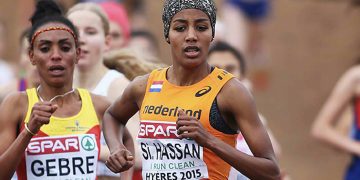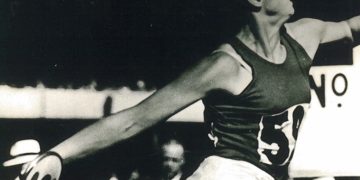 Museum of World Athleticsâ„¢, by World Athletics
Museum of World Athleticsâ„¢, by World Athletics
When World Athletics sent over a press release and invite on the virtual launch, I took some time to check out this museum. I have gone back five times and expect to go back more.
Museum of World Athletics is a celebration of our sport. Using a 3d format developed by Dysport, a digital sports company led by Olympic gold medalist and 2004 World Indoor Champion Jason Gardener.
If World Athletics wants to get out the cool history and emotion of our sport, then they have gone down a good road. The artifacts, photos, video bring the stories to the viewer, and the objects bring it alive.
Well done WA! The Museum of Athletics is a global celebration of sport! We highly recommend keeping the link close and sharing with track friends!
World Athletics has announced the launch of a 3D virtual museum of athletics, bringing a new level of innovation and creative technologies to the world of sport.
Known as MOWA, the Museum of World Athleticsâ„¢ is the first sports museum to be established solely in the digital world.
It offers visitors an interactive journey through the history of athletics and the sport’s flagship World Athletics Championships, highlighting many of the sport’s legends.
The museum gives visitors a unique online experience, highlighting key athletics champions from each continent and celebrating each edition of the World Athletics Championships through realistic interactive content, including items donated by the athletes, which help tell the story of the sport.
Among the exhibits are items owned by many of the greatest athletes in history, including Paavo Nurmi, Jesse Owens, Fanny Blankers-Koen, Irena Szewinska, Carl Lewis, Marie-Jose Perec, Jan Zelezny, Allyson Felix, and Usain Bolt.
World Athletics President Sebastian Coe said MOWA was the perfect platform to showcase the extensive heritage of athletics, a foundation sport and the No.1 Olympic sport.
“We are delighted to be the first international sports federation to bring a 3D virtual sports museum to a global audience,” Coe said. “Through MOWA, sport, and museums, fans from around the world will, without the geographical limitations of a physical location, be able to discover the fascinating history of athletics and the amazing achievements of our athletes. It is fascinating to launch this project when the pandemic has limited the ability of fans to attend sporting events or visit museums in person.
“Athletics is the most accessible and diverse sport in the world and we were keen for the museum to reflect that by making the platform accessible to everyone, no matter where you are and what device you use.”
Smooth and immersive visitor experience
To create the museum, World Athletics worked with digital sports company Dysport, led by Olympic gold medallist and 2004 world indoor 60m champion Jason Gardener, who brought his expertise and passion for the sport to the project.
Through cutting-edge 3D technology, MOWA is designed to look and feel like a real building with stunning rooms that create an amazing and engaging real-life feel.
The journey begins by entering through a large reception hall, which features the six continental displays, before moving through an ‘Origins Tunnel’ which follows athletics’ 3000-year journey from antiquity to the modern-day and arriving at the ‘World Championships Room’, which features all 17 editions of World Athletics’ flagship championships.
The visitor can roam around the museum freely and interact with more than 60 exhibits and more than 400 items of supporting content: text, photos, and video.
One of the biggest technical challenges was to build a digital environment where the modeling of the memorabilia donated by the athletes would look real. To ensure that the photographic reproduction and the graphics quality and clarity were perfect, all the artifacts, including competition uniforms, spike shoes, and medals, were photographed in 360 degrees with a picture taken every 10 degrees, using a total of 36 images per item. The clarity of the graphics and the quality of the photographic reproduction is state of the art.
New donations announced for the MOWA opening
To celebrate the opening of MOWA, World Athletics is also delighted to announce new donations from two of the most celebrated athletes of the 20th Century, 1960 Olympic 1500m champion Herb Elliott of Australia and 1983 world marathon champion Grete Waitz of Norway.
Elliott has placed on long-term loan the Australian singlet and number he wore to triumph at the 1960 Rome Olympic Games, setting a world record that stood for almost seven years. Waitz’s husband and coach Jack Waitz have donated Waitz’s autographed 1982 season running shoes.
“I am proud about Grete’s contribution to women’s running,” confirmed Jack Waitz. “The whole situation was changed in Norway. Women dared to go out to run and dared to go out to run road races.”
Two World Athletics Heritage Plaques are also being awarded, posthumously, to Elliott’s charismatic coach Percy Cerutty and to Waitz, who died of cancer in 2011, aged just 57. The Cerutty plaque is to be located in Portsea in Australia, where he ran his famously spartan ‘Stotan’ training camps, and the Waitz plaque is proposed for Bislett Stadium in Oslo, where she twice broke the world 3000m record.
“I would not be who I am or where I am without the lucky accident of meeting Percy when I was still at school,” reflected Herb Elliott. “He was highly inspiring. To hear Percy talk, you wanted to go out and shake the trees and shake the world.”
Demonstrating the unmatched universality of athletics, the museum features athletes from more than 30 countries and all six continental areas. The six areas (Africa, Asia, Europe, North and Central America, Oceania, and South America) each have a section devoted to the history of athletics in their region.
The museum includes other carefully thought-out details such as the lines of an athletics track on the virtual floor to guide visitors, and even features the shadows of the objects, providing a convincingly immersive experience for sports and museum fans.
The project took six months to bring to life and was designed with the capacity to evolve over time. World Athletics will continue to add new features and galleries regularly, beginning with an Olympic exhibition, which will open in July, before the Tokyo Olympic Games commence.
The Museum of World Athleticsâ„¢ (MOWA) is now available for free, with commentary provided in both English and French languages. The Museum is hosted by the official World Athletics website and is accessible at www.worldathletics.org/mowa
#MuseumOfWorldAthletics #MOWA #WhereChampionsLive
Note to editors:
Demonstrating the unmatched universality of athletics, the museum features athletes from more than 30 countries and all six continental areas. The six areas (Africa, Asia, Europe, North and Central America, Oceania, and South America) each have a section devoted to the history of athletics in their region. Some of the athletes featured in each continent are listed below:
Africa
Seven athletes from Africa are featured in the first stage of the museum which was opened today. The powerhouses of Ethiopia (the great Haile Gebrselassie, five-times world champion outdoors, dual Olympic gold medallist and setter of 20 ratified world records; and 1999 world 10,000m champion Gete Wami) and Kenya (Vivian Cheruiyot, the 2009 and 2011 world 5000m champion and 2016 Olympic gold medallist) are well represented. Morocco’s Nawal El Moutawakel (the 1984 Olympic 400m hurdles champion, now a Council member of World Athletics) and Nezha Bidouane (the 1997 and 2001 world 400m hurdles champion), Algeria’s Hassiba Boulmerka (the 1991 and 1995 world 1500m champion and 1992 Olympic gold medallist) and Mozambique’s Maria Mutola (1993, 2001 and 2003 world 800m champion and 2000 Olympic gold medallist).
Asia
Three athletes from Asia are featured in the first stage of the museum which was opened today, China’s Liu Xiang (the 2007 world 110m hurdles champion and the first Chinese athlete to win an Olympic gold medal) and Wang Hao (the 2009 world 20km race walk champion) and Qatar’s Mutaz Essa Barshim (the 2017 and 2019 world high jump champion).
Europe
The traditional strength of Europe is well-represented in the first stage of the museum with 30 athletes from 16 countries featured.
They include five athletes from Great Britain (among them world triple jump champion and world record-holder Jonathan Edwards; six-time world champion and four-time Olympic gold medallist Mo Farah; and 1980 and 1984 Olympic 1500m champion Sebastian Coe, now the president of World Athletics), four from Finland (including the great distance-running duo of Paavo Nurmi and Lasse Viren), and three from France and Poland (including Marie-Jose Perec, the 1991 and 1995 world 400m champion and triple Olympic gold medallist, and Irena Szewinska, the triple Olympic gold medallist, who is the only athlete to hold the 100m, 200m, and 400m world records simultaneously).
Other all-time greats who have memorabilia in the museum are the Dutch champion Fanny Blankers-Koen (four Olympic gold medals and 12 world records) and the Czech javelin supremo Jan Zelezny (triple world and Olympic champion and the current world record-holder).
Oceania
Four athletes from Oceania are featured in the first stage of the museum which was opened today. Joining Herb Elliott are his fellow Australian champions Sally Pearson (the 2011 and 2017 world 100m hurdles champion) and Jana Pittman (the 2003 and 2007 world 400m hurdles champion) and New Zealand great Valerie Adams (the four-times world shot put champion, dual Olympic gold medallist and now the deputy-chair of the sport’s Athletes’ Commission).
North America, Central America, and the Caribbean
The sport’s global superpower, the United States, is strongly represented in the museum, which features 16 of the greatest US athletes, from Jesse Owens (who won four gold medals at the 1936 Olympic Games), Jim Hines (1968 Olympic 100m champion and the first man to break 10 seconds), Carl Lewis (eight-times world champion and nine-times Olympic gold medallist) and Michael Johnson (eight-times world champion and four-time Olympic gold medallist), to more modern champions including Allyson Felix (winner of 13 world titles and six Olympic gold medals), Christian Taylor (four-times world triple jump champion and dual Olympic champion) and Dalilah Muhammad (current world 400m hurdles champion, 2016 Olympic gold medallist and world record-holder).
Caribbean athletes are also prominent, represented by three Jamaican athletes, the incomparable Usain Bolt (seven-times world 100m and 200m champion and eight-time Olympic gold medallist), and fellow sprinting greats Shelly-Ann Fraser-Pryce (four-times world champion and 2012 Olympic 100m and 200m champion) and Veronica Campbell-Brown (the 2007 world 100m champion and 2011 world 200m champion and dual Olympic 200m gold medallist), and two Cubans, Alberto Juantorena (the 1976 Olympic 400m and 800m champion, now a Council member of World Athletics) and Ana Quirot (the 1995 and 1997 world 800m champion).
South America
Three athletes from South America are featured in the first stage of the museum which was opened today, Brazil’s Adhemar Da Silva (the 1952 and 1956 Olympic triple jump champion and former world record-holder), Colombia’s Caterine Ibarguen (the 2013 and 2015 world triple jump champion and 2016 Olympic gold medallist) and Ecuador’s Jefferson Perez (2003, 2005 and 2007 world 20km race walk champion and 1996 Olympic gold medallist).
Author

Larry Eder has had a 52-year involvement in the sport of athletics. Larry has experienced the sport as an athlete, coach, magazine publisher, and now, journalist and blogger. His first article, on Don Bowden, America's first sub-4 minute miler, was published in RW in 1983. Larry has published several magazines on athletics, from American Athletics to the U.S. version of Spikes magazine. He currently manages the content and marketing development of the RunningNetwork, The Shoe Addicts, and RunBlogRun. Of RunBlogRun, his daily pilgrimage with the sport, Larry says: "I have to admit, I love traveling to far away meets, writing about the sport I love, and the athletes I respect, for my readers at runblogrun.com, the most of anything I have ever done, except, maybe running itself." Also does some updates for BBC Sports at key events, which he truly enjoys. Theme song: Greg Allman, " I'm no Angel."
View all posts





















